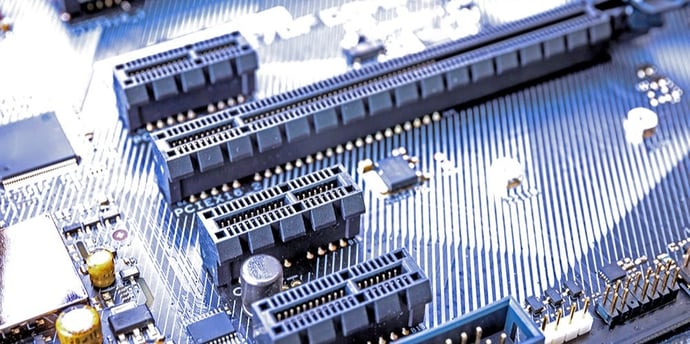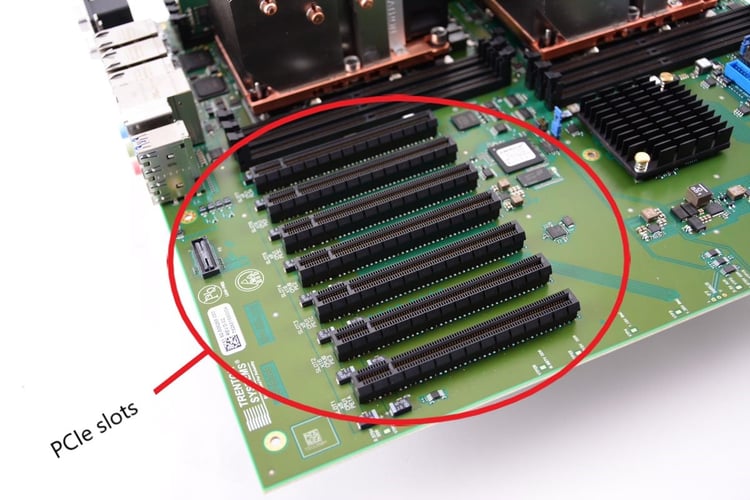Share this
PCIe Gen 4 vs. Gen 3 Slots, Speeds
by Brett Daniel on Sep 15, 2020 4:06:00 PM

Photo: In this blog post, we'll go over the differences between PCIe Gen 4 and PCIe Gen 3. We'll also discuss whether it's time for an upgrade.
Table of Contents
- What is PCI Express?
- How fast is PCIe 4.0 vs. PCIe 3.0?
- Are PCIe 4.0 and PCIe 3.0 backward and forward compatible?
- How does PCIe 4.0 influence SSD and GPU selection?
- Is upgrading to PCIe 4.0 worth it?
Make no mistake, PCIe 4.0 is twice as fast as PCIe 3.0.
But whether it’s time to upgrade your hardware to support PCIe Gen 4 is a different matter altogether.
In this blog post, we’ll discuss the speed differences between both generations and address backward and forward compatibility.
Then, we’ll touch on whether upgrading is right for you.
You can read more about PCI Express, how it works and its previous generations below, or you can skip right to the speed differences between PCIe 4.0 and PCIe 3.0.
Photo: Seven PCIe slots showcased on a Trenton Systems' dual Xeon Motherboard. This particular motherboard incorporates three PCIe 3.0 x16 slots and four PCIe 3.0 x8 slots for super fast speeds and versatile system expansion. At Trenton Systems, we design our own boards to fit your application-specific needs. Get in touch with us today.
What is PCI Express?
The Peripheral Component Interconnect Express (PCI Express or PCIe) is a high-speed interface standard for connecting additional graphics cards (GPUs), Local Area Network (LAN) ports, NVME solid-state drives (SSDs), Universal Serial Bus (USB) ports and other hardware to a computer’s motherboard.
This is accomplished using expansion cards, also known as add-on cards.
Simply put, the PCI Express interface allows for the expansion of a motherboard beyond its default GPU, network and storage configurations.
The Peripheral Component Interconnect Special Interest Group (PCI-SIG), comprised of big-name technology companies like Intel, IBM, Dell, HP, AMD and NVIDIA, introduced the first generation of PCI Express, entitled PCIe 1.0, in 2003.
PCIe 2.0 and 3.0 were released in 2007 and 2010, respectively. PCIe 4.0 came out in 2017, and PCI-SIG’s latest generation, PCIe 5.0, debuted in 2019.
The PCI Express interface is actualized through PCIe slots, which vary in type depending on a motherboard's chipset.
The slots differ in both length and speed based on their number of lanes (at a minimum, one lane, and at a maximum, 16 lanes).
Slots are available in one-lane, two-lane, four-lane, eight-lane and 16-lane configurations, usually expressed as PCIe x1, x2, x4, x8 or x16.
For example, PCIe 3.0 x4 refers to a Gen 3 expansion card or slot with a four-lane configuration.
Likewise, PCIe 4.0 x16 refers to a Gen 4 expansion card or slot with a 16-lane configuration.
And so on.
Each new PCI Express generation doubles the amount of bandwidth each slot configuration can support. That's why the configurations are expressed in multiples of two.
| PCI Express: Unidirectional Bandwidth in x1 and x16 Configurations | ||||
| Generation | Year of Release | Data Transfer Rate | Bandwidth x1 | Bandwidth x16 |
| PCIe 1.0 | 2003 | 2.5 GT/s | 250 MB/s | 4.0 GB/s |
| PCIe 2.0 | 2007 | 5.0 GT/s | 500 MB/s | 8.0 GB/s |
| PCIe 3.0 | 2010 | 8.0 GT/s | 1 GB/s | 16 GB/s |
| PCIe 4.0 | 2017 | 16 GT/s | 2 GB/s | 32 GB/s |
| PCIe 5.0 | 2019 | 32 GT/s | 4 GB/s | 64 GB/s |
| PCIe 6.0 | 2021 | 64 GT/s | 8 GB/s | 128 GB/s |
Table: PCI-SIG introduced the first generation of PCI Express in 2003. With each new generation comes a doubling of data transfer rate and total bandwidth per lane configuration, the latter of which is expressed in both unidirectional and bidirectional measurements, depending on the source. To find the total unidirectional bandwidth for each lane configuration, simply multiply the x1 bandwidths listed in the table above by two, four, eight or 16. Multiply the number resulting from that calculation by two to calculate total bidirectional bandwidth. Source: PCI-SIG
For example, PCIe 1.0 has a 250 MB/s bandwidth in the one-lane configuration, a 0.500 GB/s bandwidth in the two-lane, a 1 GB/s bandwidth in the four-lane, a 2 GB/s bandwidth in the eight-lane and a 4.0 GB/s bandwidth in the 16-lane.
It’s important to note as well that these lane-specific bandwidths are often doubled to account for bidirectional travel, or data traveling to and from each lane.
Furthermore, each new generation of PCIe typically doubles its predecessor’s data rate and bandwidth for each configuration.
For example, PCIe 1.0 has a 2.5 GT/s data rate and a 250 MB/s bandwidth in the one-lane configuration, while the one-lane configuration for PCIe 2.0 supports a 5.0 GT/s data rate and a 500 MB/s bandwidth, and so forth.
But PCIe 1.0 and PCIe 2.0 are outdated.
Today, PCIe 3.0 is a motherboard standard, at least until the industry universally adopts PCIe 4.0 and eventually PCIe 5.0. And by that point, PCI-SIG will have rolled out the next generation, PCIe 6.0, which is expected in 2021.
As with any new technology, it can take computer hardware manufacturers some time to begin standardizing their motherboards with the latest PCI Express generation.
How fast is PCIe 4.0 vs. PCIe 3.0?
PCIe 4.0 is twice as fast as PCIe 3.0.
PCIe 4.0 has a 16 GT/s data rate, compared to its predecessor’s 8 GT/s. In addition, each PCIe 4.0 lane configuration supports double the bandwidth of PCIe 3.0, maxing out at 32 GB/s in a 16-lane slot, or 64 GB/s with bidirectional travel considered.
| Unidirectional Bandwidth: PCIe 3.0 vs. PCIe 4.0 | ||||
| PCIe Generation | x1 | x4 | x8 | x16 |
| PCIe 3.0 | 1 GB/s | 4 GB/s | 8 GB/s | 16 GB/s |
| PCIe 4.0 | 2 GB/s | 8 GB/s | 16 GB/s | 32 GB/s |
Table: The speed differences between PCIe 4.0 and PCIe 3.0 in each lane configuration.
Let’s use the 16-lane slot configuration to put the speed differences between PCIe 4.0 and 3.0 into perspective and make all this computer lingo a little more relatable.
For the purposes of this analogy, we’ll employ unidirectional bandwidth for both generations.

Photo: Aerial drone photograph of traffic in a metropolitan area, used to illustrate PCIe lanes.
Imagine 16 lanes of cars (data) traveling in 16 adjacent lanes (configuration) on the major PCIe 3.0 Highway (generation).
The cars are traveling at the posted PCIe 3.0 speed limit of 15 miles per hour (bandwidth).
Several miles in the opposite direction, however, the state (PCI-SIG) has just opened the PCIe 4.0 Highway and doubled the speed limit.
The cars on this highway are traveling faster at the newly posted PCIe 4.0 speed limit of 30 miles per hour.
And a couple of years from now, cars will be cruising on the PCIe 5.0 Highway, where they’ll be allowed to travel at a posted speed limit of 60 miles per hour.
And so on with each new PCI Express generation that PCI-SIG introduces.
Are PCIe 4.0 and PCIe 3.0 backward and forward compatible?
Both PCIe 4.0 and PCIe 3.0 are backward and forward compatible.
Remember those high-speed components (GPUs, NVME SSDs, etc.) that use PCIe slots to interface with the motherboard and provide additional functionality?
Thanks to backward and forward compatibility, the new can be used with the old (backward compatibility), and the old can be used with the new (forward compatibility).
For example, a PCIe 4.0 graphics card can be inserted into a motherboard’s PCIe 3.0 slot; however, the Gen 4 card’s bandwidth would be bottlenecked by the Gen 3 slot’s bandwidth limitations.
Similarly, a PCIe Gen 3 graphics card can be inserted into a motherboard’s PCIe Gen 4 slot, but the Gen 3 graphics card will be incapable of fully utilizing the higher bandwidth capabilities of the Gen 4 slot due to the card’s intrinsic bandwidth limitations.
Your expansion card doesn’t have to be installed on a slot with the same number of lanes, either.
For example, a PCIe 4.0 SSD with four lanes can be inserted into a x16 slot.
But the inverse doesn’t work.
So, a PCIe 3.0 x16 graphics card won’t fit in a x1, x2, x4 or x8 slot.
In short, the slot into which the expansion card is being inserted must have an equal or greater number of lanes.
Otherwise, the card can’t physically be inserted into the slot.

Photo: There are a few things to keep in mind when choosing PCIe 4.0 SSDs and PCIe 4.0 GPUs, mainly the population and PCIe generation of your motherboard's PCIe slots.
How does PCIe 4.0 influence SSD and GPU selection?
As previously mentioned, PCIe 4.0 is backward and forward compatible. So, you can insert a PCIe 4.0 GPU into a PCIe 3.0 slot, but you'll be bottlenecked by the bandwidth limitations of Gen 3. In other words, you won't be able to take full advantage of the increased speeds of that awesome PCIe 4.0 GPU. The same goes for PCIe SSDs, so keep this in mind when you're shopping around.
PCIe 4.0 SSD
If you're in the market for a high-speed PCIe 4.0 SSD, such as an PCIe 4.0 NVMe SSD, take comfort in knowing that you'll have the access to the latest and greatest that the PCIe specification has to offer with Gen 4, including increased data transfer rates, bandwidth, and decreased latency on the PCIe bus. This is assuming, of course, that your motherboard is equipped with PCIe Gen 4 slots into which you can insert these PCIe 4.0 SSDs.
Remember: the PCIe generation used on your motherboard's PCIe slots determines the data transfer rate and bandwidth of whatever expansion card you insert into it. PCIe 4.0 SSDs can only match the speeds of a PCIe 4.0 slot, and PCIe 3.0 SSDs can't leap in data transfer rate and bandwidth to PCIe 4.0. So, if you insert any PCIe 4.0 SSDs into previous-generation PCIe slots, you won't receive the bandwidth and data transfer rate increases you're expecting from PCIe 4.0, only the bandwidth and data transfer rate of that slot's particular PCIe generation.
There's also widespread use of PCIe 4.0 NVMe SSDs, specifically, mainly because NVMe has become the industry standard for PCIe SSDs, but also because NVMe SSDs reduce power consumption, further reduce latency, and incorporate 1,000,000 input/output operations per second (IOPS) compared to a SATA SSD's 200,000. This offers an obvious performance increase to users shopping around for PCIe 4.0 SSDs.

Photo: A GPU
PCIe 4.0 GPU
The same bandwidth and data transfer rate rules that apply to PCIe 4.0 SSDs apply to PCIe 4.0 GPUs. If you purchase a PCIe 4.0 GPU for your system and seek to benefit from PCIe Gen 4's performance increases and reduced latency, then your motherboard will need to be populated with a PCIe 4.0 slot of appropriate lane size to support your PCIe 4.0 GPU.
Otherwise, your PCIe 4.0 GPU will be stuck with previous-generation speeds, and who wants to purchase a new, shiny, expensive PCIe 4.0 GPU without, you know, reaping the benefits of PCIe 4.0?
We're starting to see more and more PCIe 4.0 GPUs pop up on the market, and it's clear that they'll play a pivotal role in streamlining and boosting the performance of data-intensive artificial intelligence (AI) and machine learning (ML) applications of the future. But the last thing you want to do is purchase one for your system and find out it's useless.
Is upgrading to PCIe 4.0 worth it?
PCIe 4.0 supports double the bandwidth of PCIe 3.0, so if you want to take advantage of the bandwidth capabilities of that PCIe 4.0 expansion card you just purchased, then you’ll need PCIe 4.0 slots on your motherboard.
It’s as simple as that.
But if you’re comfortable with a certain degree of bandwidth limitation and don’t want to spend the money to upgrade to a PCIe 4.0 motherboard, then upgrading to Gen 4 probably won’t be worth it to you.
Plus, if you’re working with PCIe 3.0 expansion cards and slots, anyway, and they’re providing you with the speeds that your application needs, then don’t worry about upgrading to Gen 4.
When deciding whether to upgrade, ask yourself two key questions:
- Are my current PCI Express cards and slots providing me with the speeds I need for my application? If yes, don’t upgrade. If no, consider upgrading.
- Will my application need a bandwidth boost soon to keep up with its increasing input/output workload? If yes, consider upgrading. If no, don’t upgrade.
Contact Trenton Systems today or chat with a member of our team to discuss whether upgrading is right for you.
Be sure to subscribe to our blog to keep up with the latest updates.
Trenton Systems creates rugged computer systems to help customers around the world meet their rugged computing needs. We stress-test our computer systems to the max, ensuring that customers can carry out industry-specific operations comfortably, effectively and smack dab in the middle of the world's harshest conditions. In other words, we stress so you don't have to.
Share this
- High-performance computers (42)
- Military computers (38)
- Rugged computers (32)
- Cybersecurity (25)
- Industrial computers (25)
- Military servers (24)
- MIL-SPEC (20)
- Rugged servers (19)
- Press Release (17)
- Industrial servers (16)
- MIL-STD-810 (16)
- 5G Technology (14)
- Intel (13)
- Rack mount servers (12)
- processing (12)
- Computer hardware (11)
- Edge computing (11)
- Rugged workstations (11)
- Made in USA (10)
- Partnerships (9)
- Rugged computing (9)
- Sales, Marketing, and Business Development (9)
- Trenton Systems (9)
- networking (9)
- Peripheral Component Interconnect Express (PCIe) (7)
- Encryption (6)
- Federal Information Processing Standards (FIPS) (6)
- GPUs (6)
- IPU (6)
- Joint All-Domain Command and Control (JADC2) (6)
- Server motherboards (6)
- artificial intelligence (6)
- Computer stress tests (5)
- Cross domain solutions (5)
- Mission-critical servers (5)
- Rugged mini PCs (5)
- AI (4)
- BIOS (4)
- CPU (4)
- Defense (4)
- Military primes (4)
- Mission-critical systems (4)
- Platform Firmware Resilience (PFR) (4)
- Rugged blade servers (4)
- containerization (4)
- data protection (4)
- virtualization (4)
- Counterfeit electronic parts (3)
- DO-160 (3)
- Edge servers (3)
- Firmware (3)
- HPC (3)
- Just a Bunch of Disks (JBOD) (3)
- Leadership (3)
- Navy (3)
- O-RAN (3)
- RAID (3)
- RAM (3)
- Revision control (3)
- Ruggedization (3)
- SATCOM (3)
- Storage servers (3)
- Supply chain (3)
- Tactical Advanced Computer (TAC) (3)
- Wide-temp computers (3)
- computers made in the USA (3)
- data transfer (3)
- deep learning (3)
- embedded computers (3)
- embedded systems (3)
- firmware security (3)
- machine learning (3)
- Automatic test equipment (ATE) (2)
- C6ISR (2)
- COTS (2)
- COVID-19 (2)
- CPUs (2)
- Compliance (2)
- Compute Express Link (CXL) (2)
- Computer networking (2)
- Controlled Unclassified Information (CUI) (2)
- DDR (2)
- DDR4 (2)
- DPU (2)
- Dual CPU motherboards (2)
- EW (2)
- I/O (2)
- Military standards (2)
- NVIDIA (2)
- NVMe SSDs (2)
- PCIe (2)
- PCIe 4.0 (2)
- PCIe 5.0 (2)
- RAN (2)
- SIGINT (2)
- SWaP-C (2)
- Software Guard Extensions (SGX) (2)
- Submarines (2)
- Supply chain security (2)
- TAA compliance (2)
- airborne (2)
- as9100d (2)
- chassis (2)
- data diode (2)
- end-to-end solution (2)
- hardware security (2)
- hardware virtualization (2)
- integrated combat system (2)
- manufacturing reps (2)
- memory (2)
- mission computers (2)
- private 5G (2)
- protection (2)
- secure by design (2)
- small form factor (2)
- software security (2)
- vRAN (2)
- zero trust (2)
- zero trust architecture (2)
- 3U BAM Server (1)
- 4G (1)
- 4U (1)
- 5G Frequencies (1)
- 5G Frequency Bands (1)
- AI/ML/DL (1)
- Access CDS (1)
- Aegis Combat System (1)
- Armed Forces (1)
- Asymmetric encryption (1)
- C-RAN (1)
- COMINT (1)
- Cloud-based CDS (1)
- Coast Guard (1)
- Compliance testing (1)
- Computer life cycle (1)
- Containers (1)
- D-RAN (1)
- DART (1)
- DDR5 (1)
- DMEA (1)
- Data Center Modular Hardware System (DC-MHS) (1)
- Data Plane Development Kit (DPDK) (1)
- Defense Advanced Research Projects (DARP) (1)
- ELINT (1)
- EMI (1)
- EO/IR (1)
- Electromagnetic Interference (1)
- Electronic Warfare (EW) (1)
- FIPS 140-2 (1)
- FIPS 140-3 (1)
- Field Programmable Gate Array (FPGA) (1)
- Ground Control Stations (GCS) (1)
- Hardware-based CDS (1)
- Hybrid CDS (1)
- IES.5G (1)
- ION Mini PC (1)
- IP Ratings (1)
- IPMI (1)
- Industrial Internet of Things (IIoT) (1)
- Industry news (1)
- Integrated Base Defense (IBD) (1)
- LAN ports (1)
- LTE (1)
- Life cycle management (1)
- Lockheed Martin (1)
- MIL-S-901 (1)
- MIL-STD-167-1 (1)
- MIL-STD-461 (1)
- MIL-STD-464 (1)
- MOSA (1)
- Multi-Access Edge Computing (1)
- NASA (1)
- NIC (1)
- NIC Card (1)
- NVMe (1)
- O-RAN compliant (1)
- Oil and Gas (1)
- Open Compute Project (OCP) (1)
- OpenRAN (1)
- P4 (1)
- PCIe card (1)
- PCIe lane (1)
- PCIe slot (1)
- Precision timestamping (1)
- Product life cycle (1)
- ROM (1)
- Raytheon (1)
- Remotely piloted aircraft (RPA) (1)
- Rugged computing glossary (1)
- SEDs (1)
- SIM Card (1)
- Secure boot (1)
- Sensor Open Systems Architecture (SOSA) (1)
- Small form-factor pluggable (SFP) (1)
- Smart Edge (1)
- Smart NIC (1)
- SmartNIC (1)
- Software-based CDS (1)
- Symmetric encryption (1)
- System hardening (1)
- System hardening best practices (1)
- TME (1)
- Tech Partners (1)
- Total Memory Encryption (TME) (1)
- Transfer CDS (1)
- USB ports (1)
- VMEbus International Trade Association (VITA) (1)
- Vertical Lift Consortium (VLC) (1)
- Virtual machines (1)
- What are embedded systems? (1)
- Wired access backhaul (1)
- Wireless access backhaul (1)
- accredidation (1)
- aerospace (1)
- air gaps (1)
- airborne computers (1)
- asteroid (1)
- authentication (1)
- autonomous (1)
- certification (1)
- cognitive software-defined radios (CDRS) (1)
- command and control (C2) (1)
- communications (1)
- cores (1)
- custom (1)
- customer service (1)
- customer support (1)
- data linking (1)
- data recording (1)
- ethernet (1)
- full disk encryption (1)
- hardware monitoring (1)
- heat sink (1)
- hypervisor (1)
- in-house technical support (1)
- input (1)
- integrated edge solution (1)
- international business (1)
- licensed spectrum (1)
- liquid cooling (1)
- mCOTS (1)
- microelectronics (1)
- missile defense (1)
- mixed criticality (1)
- moving (1)
- multi-factor authentication (1)
- network slicing (1)
- neural networks (1)
- new headquarters (1)
- next generation interceptor (1)
- non-volatile memory (1)
- operating system (1)
- output (1)
- outsourced technical support (1)
- post-boot (1)
- pre-boot (1)
- private networks (1)
- public networks (1)
- radio access network (RAN) (1)
- reconnaissance (1)
- rugged memory (1)
- secure flash (1)
- security (1)
- self-encrypting drives (SEDs) (1)
- sff (1)
- software (1)
- software-defined radios (SDRs) (1)
- speeds and feeds (1)
- standalone (1)
- storage (1)
- systems (1)
- tactical wide area networks (1)
- technical support (1)
- technology (1)
- third-party motherboards (1)
- troposcatter communication (1)
- unlicensed spectrum (1)
- volatile memory (1)
- vpx (1)
- zero trust network (1)
- January 2025 (1)
- November 2024 (1)
- October 2024 (1)
- August 2024 (1)
- July 2024 (1)
- May 2024 (1)
- April 2024 (3)
- February 2024 (1)
- November 2023 (1)
- October 2023 (1)
- July 2023 (1)
- June 2023 (3)
- May 2023 (7)
- April 2023 (5)
- March 2023 (7)
- December 2022 (2)
- November 2022 (6)
- October 2022 (7)
- September 2022 (8)
- August 2022 (3)
- July 2022 (4)
- June 2022 (13)
- May 2022 (10)
- April 2022 (4)
- March 2022 (11)
- February 2022 (4)
- January 2022 (4)
- December 2021 (1)
- November 2021 (4)
- September 2021 (2)
- August 2021 (1)
- July 2021 (2)
- June 2021 (3)
- May 2021 (4)
- April 2021 (3)
- March 2021 (3)
- February 2021 (8)
- January 2021 (4)
- December 2020 (5)
- November 2020 (5)
- October 2020 (4)
- September 2020 (4)
- August 2020 (6)
- July 2020 (9)
- June 2020 (11)
- May 2020 (13)
- April 2020 (8)
- February 2020 (1)
- January 2020 (1)
- October 2019 (1)
- August 2019 (2)
- July 2019 (2)
- March 2019 (1)
- January 2019 (2)
- December 2018 (1)
- November 2018 (2)
- October 2018 (5)
- September 2018 (3)
- July 2018 (1)
- April 2018 (2)
- March 2018 (1)
- February 2018 (9)
- January 2018 (27)
- December 2017 (1)
- November 2017 (2)
- October 2017 (3)
/Trenton%20Systems%20Circular%20Logo-3.png?width=50&height=50&name=Trenton%20Systems%20Circular%20Logo-3.png)

Comments (91)